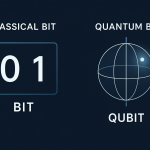Abstract
The global rise of antimicrobial resistance (AMR) poses one of the most significant threats to modern healthcare, rendering conventional antibiotics increasingly ineffective. Traditional antibiotic discovery methods are slow, costly, and insufficient to match the pace of emerging resistant pathogens. The convergence of quantum computing, artificial intelligence (AI), and biotechnology—referred to as Quantum Artificial Intelligence (QAI)—represents a paradigm shift in drug discovery. QAI exploits quantum mechanics to efficiently simulate molecular interactions, combined with AI-driven analytics to optimize lead compound identification, predict bacterial resistance mechanisms, and enable precision therapeutics. This review provides an in-depth analysis of QAI principles, its applications in antibiotic research, existing challenges, ethical considerations, and potential transformative impact on global health.
1. Introduction
Antibiotics have revolutionized medicine, saving millions of lives since the discovery of penicillin. However, antimicrobial resistance (AMR) has emerged as a global crisis, with projections suggesting 10 million deaths annually by 2050 if unaddressed (O’Neill, 2016). The antibiotic pipeline has stagnated due to scientific, economic, and regulatory challenges. Traditional drug discovery relies heavily on high-throughput screening and computational chemistry, which, despite advances, remain constrained by classical computing limitations when modeling complex biological systems.
Quantum Artificial Intelligence (QAI)—the integration of quantum computing’s unparalleled computational capabilities with AI’s pattern recognition and predictive modeling—offers a promising solution. By leveraging quantum-enhanced algorithms, QAI can explore vast chemical spaces, simulate protein-ligand interactions at atomic resolution, and accelerate drug development cycles.
2. The Foundations of Quantum Artificial Intelligence
2.1 Quantum Computing in Drug Discovery
Quantum computing harnesses superposition, entanglement, and quantum parallelism to solve problems intractable for classical machines. For drug discovery:
-
Molecular Simulation: Quantum algorithms like Variational Quantum Eigensolver (VQE) and Quantum Phase Estimation (QPE) enable accurate computation of molecular energy landscapes (Cao et al., 2019).
-
Optimization Problems: Algorithms such as Quantum Approximate Optimization Algorithm (QAOA) facilitate rapid conformational search in protein-ligand docking.
2.2 Artificial Intelligence and Machine Learning
AI in drug discovery traditionally involves:
-
Deep Learning for bioactivity prediction,
-
Reinforcement Learning for generative molecule design,
-
Natural Language Processing (NLP) for mining biomedical literature.
When enhanced by quantum computing, these methods—Quantum Support Vector Machines (QSVMs), Quantum Neural Networks (QNNs)—demonstrate superior scalability and accuracy.
2.3 Hybrid Quantum-Classical Models
Given current hardware constraints, hybrid approaches dominate:
-
Classical pre-processing reduces data dimensionality,
-
Quantum backends solve sub-problems (e.g., binding affinity calculations),
-
Iterative feedback loops improve model performance.
3. Applications of QAI in Antibiotic Development
3.1 Accelerated Drug Discovery
QAI enables:
-
Massive Parallel Screening: Simultaneous evaluation of millions of compounds against bacterial targets.
-
Accurate Binding Predictions: Quantum simulations refine docking scores beyond classical approximations.
-
Hit-to-Lead Optimization: Integration with AI-driven generative models shortens lead identification timelines.
3.2 Overcoming Antimicrobial Resistance
By analyzing:
-
Genomic Variability: Quantum-enhanced ML predicts emergent resistance-conferring mutations.
-
Pathogen Evolutionary Pathways: Modeling adaptive landscapes supports proactive drug design.
-
Network-Based Approaches: QAI integrates host-pathogen interaction data for multi-target therapeutics.
3.3 Precision and Personalized Antibiotic Therapy
Combining patient-specific genomic, microbiome, and pharmacokinetic data with QAI:
-
Optimizes antibiotic choice,
-
Minimizes off-target effects,
-
Reduces selective pressure for resistance.
4. Challenges and Ethical Considerations
4.1 Technical Barriers
-
Quantum Hardware Limitations: Current Noisy Intermediate-Scale Quantum (NISQ) devices are prone to decoherence and lack sufficient qubit counts.
-
Integration Complexity: Bridging quantum algorithms with biomedical pipelines remains non-trivial.
4.2 Data Privacy and Security
Handling sensitive genomic data demands robust encryption, raising questions about quantum-safe cryptography.
4.3 Ethical and Societal Issues
-
Global Access Inequality: Risk of QAI-driven antibiotics being limited to wealthy nations.
-
Dual-Use Concerns: Potential misuse in engineering resistant pathogens.
5. Future Perspectives
5.1 Technological Evolution
Advances in fault-tolerant quantum computing, cloud-based quantum services, and AI interpretability will broaden QAI’s applicability.
5.2 Integration with Other Disciplines
-
Synthetic Biology: QAI-guided engineering of antimicrobial peptides and phage therapies.
-
Global Surveillance Networks: Real-time adaptation of antibiotic strategies to epidemiological data.
5.3 Policy and Regulation
Collaborative frameworks are essential to:
-
Standardize QAI-driven drug validation,
-
Ensure ethical deployment,
-
Support equitable distribution.
6. Conclusion
Quantum Artificial Intelligence heralds a transformative era in antibiotic research, bridging the gap between biological complexity and computational capability. By unlocking unprecedented insights into molecular interactions, predicting resistance mechanisms, and enabling tailored therapies, QAI could become a cornerstone of 21st-century precision medicine. However, realizing this potential requires technological breakthroughs, ethical safeguards, and global collaboration.
References
-
Arute, F. et al. (2019). Quantum supremacy using a programmable superconducting processor. Nature, 574(7779), 505–510.
-
Biamonte, J. et al. (2017). Quantum machine learning. Nature, 549(7671), 195–202.
-
Cao, Y. et al. (2019). Quantum chemistry in the age of quantum computing. Chemical Reviews, 119(19), 10856–10915.
-
Schuld, M., & Petruccione, F. (2018). Supervised Learning with Quantum Computers. Springer.
-
Ventola, C. L. (2015). The antibiotic resistance crisis: part 1: causes and threats. P&T, 40(4), 277–283.
-
O’Neill, J. (2016). Tackling drug-resistant infections globally: Final report and recommendations. Review on Antimicrobial Resistance.
-
Bharti, K. et al. (2022). Noisy intermediate-scale quantum algorithms. Reviews of Modern Physics, 94(1), 015004.

